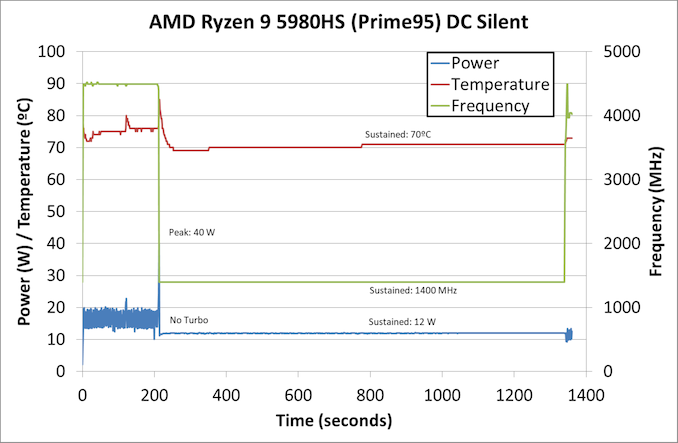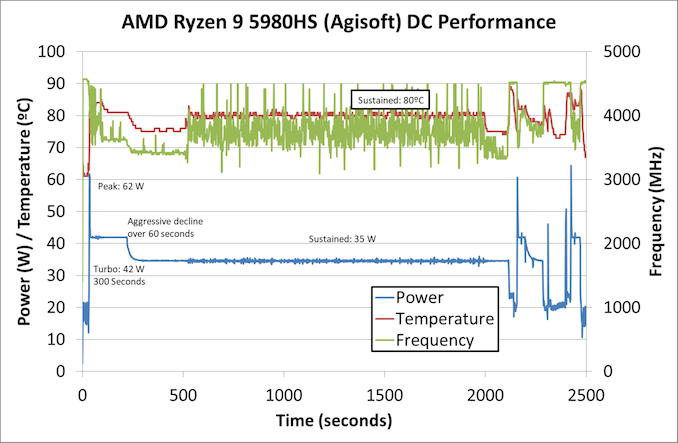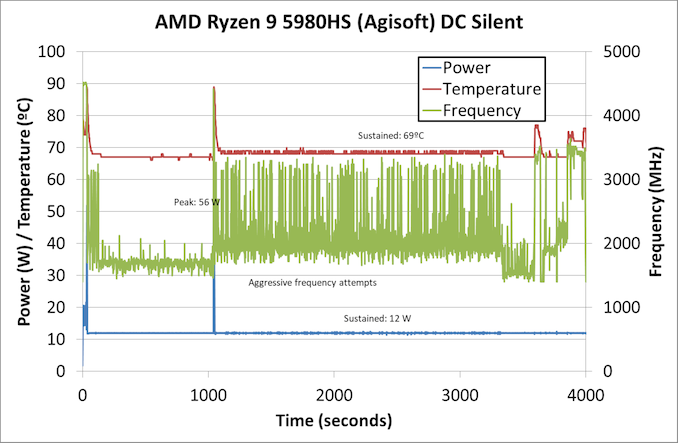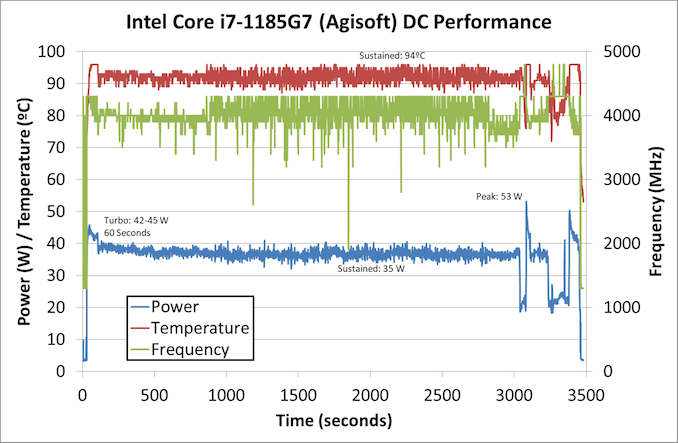AMD Ryzen 9 5980HS Cezanne Review: Ryzen 5000 Mobile Tested
by Dr. Ian Cutress on January 26, 2021 9:00 AM EST- Posted in
- CPUs
- AMD
- Vega
- Ryzen
- Zen 3
- Renoir
- Notebook
- Ryzen 9 5980HS
- Ryzen 5000 Mobile
- Cezanne
Power Consumption
The nature of reporting processor power consumption has become, in part, a dystopian nightmare. Historically the peak power consumption of a processor, as purchased, is given by its Thermal Design Power (TDP, or PL1). For many markets, such as embedded processors, that value of TDP still signifies the peak power consumption. For the processors we test at AnandTech, either desktop, notebook, or enterprise, this is not always the case.
Modern high performance processors implement a feature called Turbo. This allows, usually for a limited time, a processor to go beyond its rated frequency. Exactly how far the processor goes depends on a few factors, such as the Turbo Power Limit (PL2), whether the peak frequency is hard coded, the thermals, and the power delivery. Turbo can sometimes be very aggressive, allowing power values 2.5x above the rated TDP.
AMD and Intel have different definitions for TDP, but are broadly speaking applied the same. The difference comes to turbo modes, turbo limits, turbo budgets, and how the processors manage that power balance. These topics are 10000-12000 word articles in their own right, and we’ve got a few articles worth reading on the topic.
- Why Intel Processors Draw More Power Than Expected: TDP and Turbo Explained
- Talking TDP, Turbo and Overclocking: An Interview with Intel Fellow Guy Therien
- Reaching for Turbo: Aligning Perception with AMD’s Frequency Metrics
- Intel’s TDP Shenanigans Hurts Everyone
In simple terms, processor manufacturers only ever guarantee two values which are tied together - when all cores are running at base frequency, the processor should be running at or below the TDP rating. While manufacturers showcase a rating on the box, motherboard manufacturers often ignore it and use their own settings, based on the motherboard capabilities, making the CPU vendor ratings somewhat useless. The crucial thing is though, the CPU vendors actively encourage the motherboard vendors doing their own thing, creating confusion as to the real power consumption for the workload, and if the frequency on the box is actually what the user is going to get.
For laptops, it gets even worse than desktops. On a laptop, power consumption and frequency control are key parts of the design ethos, however we end up with nested-upon-nested options for power control. While the CPU vendor will have their own power control levels in firmware, the laptop vendor will have another set on top of this in the BIOS, and then the operating system will have another set on top of this, followed by another layer of laptop vendor software. Its turtles all the way down, and each variation produces something quite different.
AMD recommends that all the power levels be left where they are, and the user only controls the vendor software power options. In this case ASUS offers two modes: Silent and Performance. We mentioned these on the first page of this review, and showcased some odd numbers. It might be more striking if I just show the comparison.
To start, I’m simply going to showcase what a full sustained 10 minute CPU load does, first in Performance mode.
P95 is a heavy AVX workload for this processor, and in performance mode we see the processor peak at 56 W for a couple of seconds, and then hit its turbo mode at 42 W for 300 seconds. During this time we’re around 4000 MHz on all eight cores and sixteen threads, and the system cooling is keeping it around 80ºC. Once the 300 seconds has finished, the system slowly decreases to 35 W and 75ºC over the course of 60 seconds, before hitting a consistent 35 W. The frequency bounces as low as 3200 MHz, likely in line with the instructions from the test.
Now similarly, let’s go to the same benchmark in ‘Silent’ mode.
This looks a lot different. Here the system is prioritizing noise over anything else, and that also means reducing voltages and frequencies to the point of absurdity. There is no turbo to speak of in this workload, and the system comes down to 1400 MHz sustained at 70ºC and 12 W. This is still all eight cores, and the system is still quiet, but that is the tradeoff in these designs.
Moving to a more user-friendly workload, Agisoft, which is a mix of ST and MT.
At the start of the test we see the power peak at 62 W for a second or two, before coming down to a 300 second turbo of around 42 W. During this time the frequency comes down to around 3650 MHz, before reducing to 3400 MHz as the turbo budget runs out and the system drops to 35 W for a sustained mode. The second part of the test, which is multi-threaded, starts at around 500 seconds and showcases a sustained temperature of around 81ºC and an opportunistic frequency peaking at 4500 MHz, all while staying at 35 W. Towards the end of the test, as we start looking at single threaded workloads, the system peaks above 60 W on two occasions, but also shows 4500 MHz for ST activity. The CPU temperature rises more to 90ºC as the preferred core is used, but as it is only a single core the thermals are better managed and adjust accordingly.
The same workload in silent mode stays at 12 W for almost the entire test. We get a couple of peaks to 56 W, but the system tries to both stay quiet and stay around 68-69ºC by reducing frequency and power. The CPU still tries to remain opportunistic as we can see from the very spikey frequency graph in green, but it is in the region of 1700 MHz to 3300 MHz for most of the test. So while it takes 2443 seconds in performance mode, the same test takes 4059 seconds in silent mode.
This is probably showcasing the worst performance disparity between the two. In a lot of CPU tests, as you’ll see in this review, the differences can be minor. It showcases just how important it is to profile what workload you are running, and keep a close eye on what performance mode the system is running at (there isn’t a clear sign without actively checking the software).
Suffice to say however, in these tests, we do see a peak of 62-65 W on the Ryzen 9 5980HS. It is for all intents and purposes the briefest of spikes, and we don’t necessarily see any thermal increase to the extent that another 10 seconds of workload at 42-45 W does. The sustained turbo mode for 300 seconds is an impressive turbo mode that allows for higher frequencies in most workloads, with only the super sustained tests that might be more at home on a workstation or 15-to-17-inch notebook causing the processor to hit 35 W TDP. It also comes down to thermals, and given the design and temperatures we’re seeing, the ROG Flex 13 is very much a notebook, than a ‘laptop’. Users looking to actually use it on their lap would probably be best creating a thermal profile that keeps the temperature low at the expense of fan noise. When we examine the laptop in further detail, we’ll cover the issue of fan noise.
For completeness, here’s the Agisoft graph for the MSI Prestige 14 Evo in performance mode. Intel enables a turbo of 60 seconds, on which we see 42-45 W, although the peak observed is 53 W later in the test. We do see a sustained 35 W mode, averaging around 4000 MHz on all four cores. But what is perhaps worrying is the temperature, being reported as a sustained 92-94ºC on average. That’s quite high. Where the Ryzen 9 5980HS takes 2443 seconds to complete the benchmark, the Intel system takes 3389 seconds.















218 Comments
View All Comments
Lemnisc8 - Tuesday, January 26, 2021 - link
Can someone PLEASE find out if this thing is running in quad channel or dual channel lpddr4x. It’s already at a disadvantage since lpddr4x has half the bus width of standard ddr4. It would be fine if it ran in quad channel because it’s bus width would then be the same size as ddr4 at 128 bits, but no reviews anywhere show what channel configuration it’s running in...neblogai - Tuesday, January 26, 2021 - link
I don't think there were any 4000-series laptops running LPDDR4x just dual channel- I've only seen it to be quad-channel. So this flagship device (and used by AMD to impress about 5000H performance) should be no different.xza23 - Tuesday, January 26, 2021 - link
As always , excellent article , thank you!watzupken - Tuesday, January 26, 2021 - link
I feel with the introduction of Renoir, what blew most away is the fact that AMD managed to squeeze 8 cores into the U series. Not only that, the Zen 2 architecture also resulted a some serious uplift in performance as compared to the previous Zen+. This year round while it is all nice and good to see decent performance bump, the wow factor is not there. I am not expecting a core increase especially on the same N7 node, and to be honest, 8 cores is plenty of performance for a mobile PC.On the point of still using Vega, despite the age, Vega is still very competitive. One may argue that Intel's Xe graphics is better, but reviews out there proved otherwise. Xe is certainly fast, but both the iGPUs from AMD and Intel are likely memory bandwidith limited if one is pushing 1080p. Adding more cores will likely have diminishing returns. And honestly if you are a gamer, you cannot avoid getting a system with a dedicated GPU no matter how good the iGPU is.
Fulljack - Wednesday, January 27, 2021 - link
I agree, the R&D cost of moving from Vega to RDNA probably isn't worth it in the grand scheme of business.rumor has it that in 2022, Rembrandt will still leverage Zen 3 CPU but will use RDNA2 with DDR5 memory.
Ptosio - Wednesday, January 27, 2021 - link
Shouldn't it be pretty straightforward given that these APU already kind-of exist in the consoles?Hopefully Alder Lake would push AMD to offer best CPU/GPU combination they have!
As I understand, going to RDNA2 would also mean smaller core for the same performance? So there should be some savings in it for AMD as well.
Spunjji - Thursday, January 28, 2021 - link
"Shouldn't it be pretty straightforward given that these APU already kind-of exist in the consoles?"Those APUs use a totally different memory subsystem, much larger GPU slices, and they also use Zen 2 cores. AMD were specifically aiming to get Zen 3 out across their range - there's probably a lot of work needed to scale RDNA 2 down to iGPU levels without unbalancing its performance.
zamroni - Tuesday, January 26, 2021 - link
Amd should reduce Cezanne's core count to 6 then use the transistor budget for more gpu cores.That way it will beat all Intel laptop processors at all aspects
dicobalt - Tuesday, January 26, 2021 - link
Now they need to sell a version that cuts out the silly integrated graphics and uses a faster dedicated GPU. I don't understand the motivation for having a steroid pumped 8 core CPU paired with anemic integrated graphics. It seems AMD is more interested in selling the idea of APUs than actually providing a balanced system.Zizy - Wednesday, January 27, 2021 - link
AMD is clear that integrated GPU is for the very same chip at 15W. It is a pretty fine GPU there, TDP and bandwidth limit potential anyway. I wonder what is the die area saving by ditching GPU. If it is sizeable then yeah, it would be great to have a GPU-less variant of the chip, especially with current wafer supply issues.